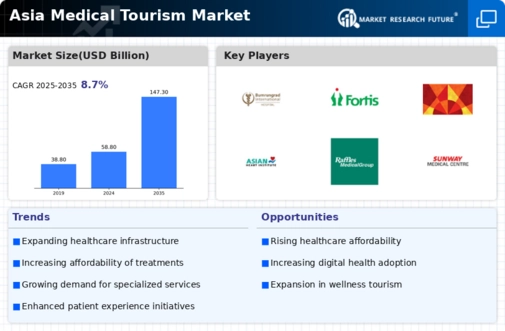Advancements in Medical Technology
Technological advancements play a pivotal role in the Global Asia Medical Tourism Market Industry. Countries such as Singapore and South Korea are at the forefront of medical innovation, offering cutting-edge treatments and procedures. For example, the use of robotic surgery and minimally invasive techniques has enhanced patient outcomes and reduced recovery times. These advancements not only attract international patients but also bolster the reputation of Asian countries as medical tourism hubs. As the industry evolves, it is anticipated that the market will grow significantly, potentially reaching 147.3 USD Billion by 2035, driven by the continuous improvement in healthcare technology.
Government Support and Initiatives
Government initiatives aimed at promoting medical tourism are crucial for the Global Asia Medical Tourism Market Industry. Many Asian governments have implemented policies to attract foreign patients, such as streamlined visa processes and the establishment of medical tourism boards. For instance, Thailand's government has actively promoted its healthcare services, resulting in a substantial influx of international patients seeking treatments. These supportive measures not only enhance the visibility of medical facilities but also improve the overall patient experience. As a result, the market is likely to experience a robust growth trajectory, with a projected CAGR of 8.7% for the period from 2025 to 2035.
Aging Population and Chronic Diseases
The aging population and the prevalence of chronic diseases are key drivers of the Global Asia Medical Tourism Market Industry. As populations in developed countries age, there is a corresponding increase in demand for medical treatments, particularly for age-related conditions. Asian countries, with their advanced healthcare systems and specialized services, are well-positioned to cater to this demographic. For example, countries like Japan and Singapore offer comprehensive geriatric care and advanced treatment options for chronic illnesses. This demographic shift is likely to fuel the growth of medical tourism, as older patients seek high-quality care in more affordable settings.
Growing Demand for Cosmetic Procedures
The increasing demand for cosmetic procedures significantly influences the Global Asia Medical Tourism Market Industry. Countries like South Korea and Thailand are renowned for their cosmetic surgery offerings, attracting patients from around the globe seeking aesthetic enhancements. The affordability and quality of procedures such as rhinoplasty and breast augmentation in these countries are compelling factors for international patients. This trend is expected to continue, with the market expanding as more individuals seek cosmetic solutions abroad. The growth in this sector contributes to the overall market expansion, reinforcing Asia's position as a premier destination for cosmetic medical tourism.
Rising Healthcare Costs in Developed Countries
The Global Asia Medical Tourism Market Industry is driven by the escalating healthcare costs in developed nations. Patients from countries such as the United States and Canada are increasingly seeking affordable medical treatments abroad. For instance, procedures like hip replacements or cardiac surgeries can cost significantly less in countries like India or Thailand compared to their home countries. This trend is expected to contribute to the market's growth, with the industry projected to reach 58.8 USD Billion in 2024. The financial incentive for patients to travel for medical care highlights the potential for Asia to become a leading destination for cost-effective healthcare solutions.



















Leave a Comment